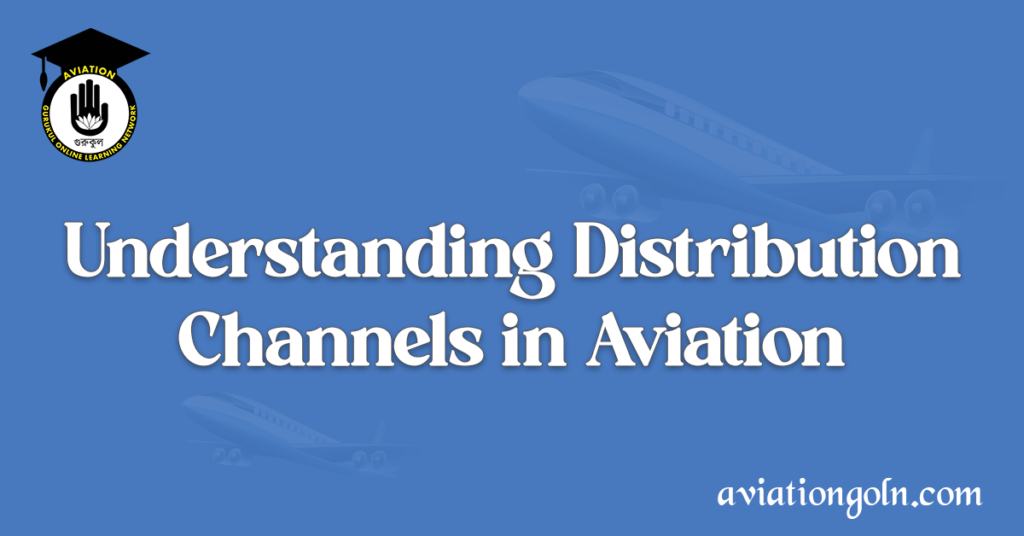Understanding Distribution Channels in Aviation: The aviation industry, with its sprawling global reach and intricate network of operations, is a massive contributor to the world economy. But how do airlines ensure that their services reach the right audience? The answer lies in mastering the intricate web of distribution channels. In this article, we delve into understanding these channels in aviation, looking into how they aid in sales and the advantages and challenges they bring.
Understanding Distribution Channels in Aviation
1. Introduction to Distribution Channels in Aviation
Distribution channels in aviation refer to the various means through which airlines get their products (tickets and ancillary services) to the end consumer. Each channel has its operating model, cost structure, and strategic relevance.
2. Types of Distribution Channels in Aviation
A. Direct Channels:
- Airline Websites: The airline’s official website where consumers can book flights directly.
- Mobile Apps: Dedicated apps offering booking services, check-in, and other flight-related functionalities.
- Airline Call Centers: Customers can book or change reservations via phone.
B. Indirect Channels:
- Travel Agents: Traditional agents offer ticket booking services, often providing added insights and expertise.
- Online Travel Agents (OTAs): Websites like Expedia, Kayak, or Booking.com that aggregate flight options from various airlines.
- Global Distribution Systems (GDS): These are vast reservation networks used by travel agents to find and book flights for customers. Examples include Amadeus, Sabre, and Travelport.
3. Advantages of Direct vs. Indirect Distribution Channels
Direct Channels:
- Increased Profit Margins: Airlines can save on commission fees to third-party agents.
- Direct Customer Relationship: Airlines can gather more data on customer preferences and habits, leading to better marketing and service personalization.
- Greater Control: Overpricing, promotions, and inventory.
Indirect Channels:
- Extended Reach: Access to a broader customer base, especially in regions where the airline might not have a strong presence.
- Expertise and Upselling: Traditional travel agents can provide a curated experience, bundling flights with hotels or tours.
- Comparative Advantage: OTAs allow consumers to compare prices and schedules across various airlines.
4. How Distribution Channels Influence Sales
A. Pricing Dynamics: The distribution channel plays a role in ticket pricing. Indirect channels might include commission fees, whereas direct channels allow airlines to offer exclusive discounts or packages.
B. Visibility and Access: Prominent placement on OTAs or GDS systems can increase an airline’s bookings, as many consumers use these platforms to compare and purchase tickets.
C. Packaging and Bundling: Indirect channels, especially OTAs, often bundle flight tickets with other travel services, offering comprehensive packages that can attract more customers.
D. Consumer Trust: Established platforms or reputed travel agents might instill more trust in some consumers, leading to higher sales through these channels.
5. Evolution of Distribution Channels: The Rise of NDC
The New Distribution Capability (NDC) is an IATA (International Air Transport Association) initiative aiming to modernize the airline distribution system. It is an XML-based data transmission standard that allows richer content to be shared between airlines and travel agents.
Benefits of NDC:
- Personalized Offers: With more data, airlines can create tailored packages or offers for individual customers.
- Enhanced Content: Airlines can display a broader range of products and services, including visuals, product descriptions, and ancillary options.
- Cost Efficiency: It provides a streamlined distribution model, reducing costs.
6. Challenges in Managing Distribution Channels
A. Integration Issues: Integrating various distribution systems, especially legacy ones with newer technology like NDC, can be complex and expensive.
B. Balancing Direct and Indirect Channels: Airlines need to ensure they don’t alienate travel agents while pushing for direct bookings.
C. Dynamic Pricing Complications: Different channels might display different prices for the same flight, leading to consumer confusion and potential distrust.
D. Commission and Fees: Indirect channels involve commissions, reducing the profit margin for airlines.
7. The Future of Distribution in Aviation
With advancements in technology and changing consumer behavior, the aviation distribution landscape is set for more transformations.
A. Blockchain in Distribution: Blockchain technology promises secure, transparent, and efficient booking systems, potentially revolutionizing distribution.
B. AI and Machine Learning: These technologies can analyze vast amounts of data, allowing airlines to create hyper-personalized offers and dynamic pricing models.
C. Direct Channel Enhancements: Airlines will likely invest more in improving their direct channels, offering loyalty programs, exclusive deals, and better user experiences.
Understanding the distribution channels in aviation is crucial for airlines to navigate the complex landscape of ticket sales and ancillary services. As the industry evolves with technology and changing consumer preferences, so will the methods of distribution. Airlines that stay agile, adapt to new systems like NDC, and prioritize customer needs will likely thrive in this dynamic environment.
See more:

